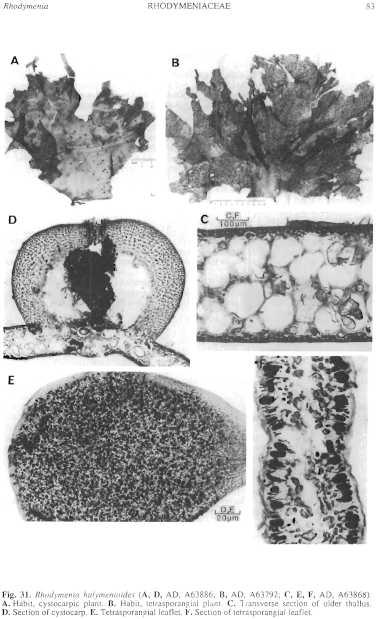|
|
|
|
|
|||||||||||
|
Electronic Flora of South Australia Species Fact Sheet
Phylum Rhodophyta – Class Florideophyceae – Order Rhodymeniales – Family Rhodymeniaceae
Synonyms
Epymenia halymenioides J. Agardh 1876: 694; 1892: 91. De Toni 1900b: 525. Guiler 1952: 94. Kylin 1931: 23, pl. 10 fig. 24. Lucas 1929a: 18. May 1965: 407. Sonder 1881: 18. Sparling 1957: 348. Tisdall 1898: 506. Wilson 1892: 178.
Chrysymenia meredithiana J. Agardh 1876: 321. Sonder 1881: 18. Tisdall 1898: 506.
Halichrysis ?meredithiana (J. Agardh) De Toni 1900b: 536. Lucas 1929a: 19.
Erythrymenia meredithiana (J. Agardh) Kylin 1931: 13. Guiler 1952: 94.
Thallus (Fig. 31A, B) medium red, foliose, 16–20 cm high and 20–25 cm broad, with an ovate thallus irregularly lacerate or perforate, base cuneate with a compressed stipe 4–12 mm long and 1 mm thick. Surface of tetrasporangial thalli (Fig. 31B) covered with numerous ovate, stipitate, proliferations 2–5 (–8) mm long and 2–3 (–5) mm broad. Holdfast discoid, 3–4 mm across; epilithic. Structure multiaxial, developing a cortex 1–2 cells thick, outer cells ovoid in surface view and 4–6 µm in diameter, grading sharply to the medulla (Fig. 31C, D) 2–3 cells broad, cells ovoid, 50–90 µm in diameter, with intermixed smaller cells. Rhodoplasts discoid.
Reproduction: Gametangial thalli probably dioecious. Carpogonial branches and auxiliary cells not observed. Carposporophytes (Fig. 31D) 500–800 µm across with an erect, branched, fusion cell bearing dense masses of ovoid to angular carposporangia 12–25 µm in diameter. Basal nutritive tissue moderate, erect filaments disintegrating. Cystocarps scattered on the thallus surface (Fig. 31A), sessile, basally slightly constricted, 1–1.5 mm across, pericarp 200–300 µm and 12–18 cells thick, inner cells stellate, ostiolate. Spermatangia not observed.
Tetrasporangia in sori (Fig. 31E, F) on the proliferations, among cortical filaments 30–40 µm and 2–3 cells long, terminal and basally pit-connected only to inner cortical cells, ovoid, 20–40 µm long and 18–26 µm in diameter, decussately divided.
Type from Orford, Tas. (Meredith); holotype in Herb. Agardh, LD, 27057.
Selected specimens: Orford, Tas.; holotype of C. meredithiana, cystocarpic (Meredith; LD, 26474). Gordon, Tas. (Perrin, 13.ix.1942; AD, A63792, tetrasporangial and HO, fragment in AD, A63792, cystocarpic). Arch Rock, E of Ninepin Point, Tas., 5–12m deep (Sanderson, 21.x.1994; AD, A63886, tetrasporangial and cystocarpic; AD, A63868, tetrasporangial).
Distribution: SE Tasmania.
Taxonomic notes: Tetrasporangial specimens of R. halymenioides are distinctive in habit, the ovate, foliose, thallus bearing fertile proliferations over most of the surface apart from near the stipe. Cystocarps however are borne on the thallus surface and there are no surface proliferations. This difference resulted in J. Agardh in the one publication describing Orford, Tas., tetrasporangial specimens of Meredith as Epymenia halymenioides and cystocarpic ones as Chrysymenia meredithiana. The latter has been known only from the type, but recent collections of both phases have clarified their synonymy.
Rhodymenia halymenioides is here selected as the name for this species.
References:
AGARDH, J.G. (1876). Species Genera et Ordines Algarum. Vol. 3, Part 1 — Epicrisis systematis Floridearum, pp. i-vii, 1–724. (Weigel: Leipzig.)
AGARDH, J.G. (1892). Analecta Algologica. Acta Univ. lund. 28, 1–182, Plates 1–3.
DE TONI, G.B. (1900b). Sylloge Algarum omnium hucusque Cognitarum. Vol. 4. Florideae. Sect. 2, pp. 387–776. (Padua.)
GUILER, E.R. (1952). The marine algae of Tasmania. Check List with localities. Pap. Proc. R. Soc. Tasm. 86, 71–106.
KYLIN, H. (1931). Die Florideenordnung Rhodyméniales. Lunds Univ. Årsskr. N.F. Avd. 2, 27 (11), 1–48, Plates 1–20.
LUCAS, A.H.S. (1929a). The marine algae of Tasmania. Pap. Proc. R. Soc. Tasm. 1928, 6–27.
MAY, V. (1965). A census and key to the species of Rhodophyceae (red algae) recorded from Australia. Contr. N.S.W. natn. Herb. 3, 349–429.
SONDER, O.W. (1881). In Mueller, F., Fragmenta Phytographiae Australiae. Supplementum ad volumen undecinum: Algae Australianae hactenus cognitae, pp. 1–42, 105–107. (Melbourne.)
SPARLING, S.R. (1957). The structure and reproduction of some members of the Rhodymeniaceae. Univ. Calif Pubis Bot. 29, 319–396.
TISDALL, H.T. (1898). The algae of Victoria. Rep. 7th Meet. Aust. Ass. Adv. Sci., Sydney, 1898, pp. 493–516.
WILSON, J.B. (1892). Catalogue of algae collected at or near Port Phillip Heads and Western Port. Proc. R. Soc. Vict. 4, 157–190.
The Marine Benthic Flora of Southern Australia Part IIIB complete list of references.
Publication:
Womersley, H.B.S. (28 June, 1996)
The Marine Benthic Flora of Southern Australia
Rhodophyta. Part IIIB. Gracilarialse, Rhodymeniales, Corallinales and Bonnemaisoniales
Reproduced with permission from The Marine Benthic Flora of Southern Australia Part IIIB 1996, by H.B.S. Womersley. Australian Biological Resources Study, Canberra. Copyright Commonwealth of Australia.
Illustration in Womersley Part IIIA, 1996: FIG. 31.

Figure 31 enlarge
Fig. 31. Rhodymenia halymenioides (A, D, AD, A63886; B, AD, A63792; C, E, F, AD, A63868). A. Habit, cystocarpic plant. B. Habit, tetrasporangial plant. C. Transverse section of older thallus. D. Section of cystocarp. E. Tetrasporangial leaflet. F. Section of tetrasporangial leaflet.

|
Email Contact: State Herbarium of South Australia |

|